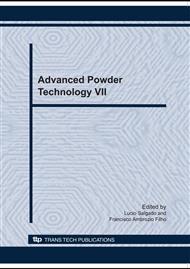p.139
p.145
p.152
p.158
p.164
p.170
p.176
p.182
p.188
Quantitative Determination of the Crystalline Phases of the Ceramic Materials Utilizing the Rietveld Method
Abstract:
Ceramic materials have properties defined by their chemical and micro-structural composition. The quantification of the crystalline phases is a fundamental stage in the determination of the structure, properties and applications of a ceramic material. Within this context, this study aims is the quantitative determination of the crystalline phases of the ceramic materials developed with addition of mineral coal bottom ash, utilizing the X ray diffraction technique, through the method proposed by Rietveld. For the formulation of the ceramic mixtures a {3,3} simplex-lattice design was used, giving ten formulations of three components (two different types of clays and coal bottom ash). The crystalline phases identified in the ceramic materials after sintering at 1150oC during two hours are: quartz, tridimite, mullite and hematite. The proposed methodology utilizing the Rietveld method for the quantification relating to crystalline phases of the materials was shown to be adequate and efficient.
Info:
Periodical:
Pages:
164-169
Citation:
Online since:
October 2010
Price:
Сopyright:
© 2010 Trans Tech Publications Ltd. All Rights Reserved
Share:
Citation:


